One of the main goals of Active Directory
is to make resources easy to find. Two of the most commonly used
resources in a networked environment are server file shares and
printers. These are so common, in fact, that most organizations have
dedicated file and print servers. When it comes to managing these types
of resources, Active Directory makes it easy to determine which files
and printers are available to users.
With that said, take a look at how Active Directory manages to publish shared folders and printers.
1. Making Active Directory Objects Available to Users
An important aspect of managing Active Directory
objects is that a systems administrator can control which objects users
can see. The act of making an Active Directory object available is
known as publishing. The two main publishable objects are Printer objects and Shared Folder objects.
The general process for creating server shares and
shared printers has remained unchanged from previous versions of
Windows: You create the various objects (a printer or a file system
folder) and then enable them for sharing.
To make these resources available via Active
Directory, however, there's an additional step: You must publish the
resources. Once an object has been published in Active Directory,
clients will be able to use it.
You can also publish Windows NT 4 resources through Active Directory by creating Active Directory objects .
When you publish objects in Active Directory, you should know the
server name and share name of the resource. When system administrators
use Active Directory objects, they can change the resource to which the
object points without having to reconfigure or even notify clients. For
example, if you move a share from one server to another, all you need
to do is update the Shared Folder object's properties to point to the
new location. Active Directory clients still refer to the resource with
the same path and name as they used before.
Without Active Directory, Windows NT 4 shares and
printers are accessible only by using NetBIOS-based shares. If you're
planning to disable the NetBIOS protocol in your environment, you must
be sure that these resources have been published or they will not be
accessible.
2. Publishing Printers
Printers can be published easily within Active Directory. This makes them available to users in your domain.
Exercise 1
walks you through the steps you need to take to share and publish a
Printer object by having you create and share a printer. In order to
complete the printer installation, you need access to the Windows
Server 2008 installation media (via the hard disk, a network share, or
the CD-ROM drive).
Click Start => Control Panel => Printers => Add Printer. This starts the Add Printer Wizard. In
the Choose A Local Or Network Printer page, select Add A Local Printer.
This should automatically take you to the next page. If it does not,
Click Next.

In
the Choose A Printer Port page, select Use An Existing Port. From the
drop-down list beside that option, make sure LPT1: (Printer Port) is
selected. Click Next.
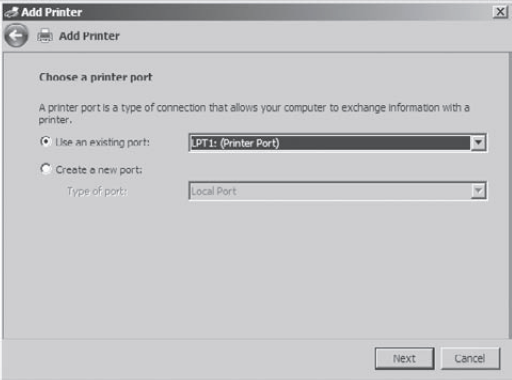
On
the Install The Printer Driver page, select Generic for the
manufacturer, and for the printer, highlight Generic / Text Only. Click
Next.

On the Type A Printer Name page, type Text Printer. Uncheck the Set As The Default Printer box and then click Next.
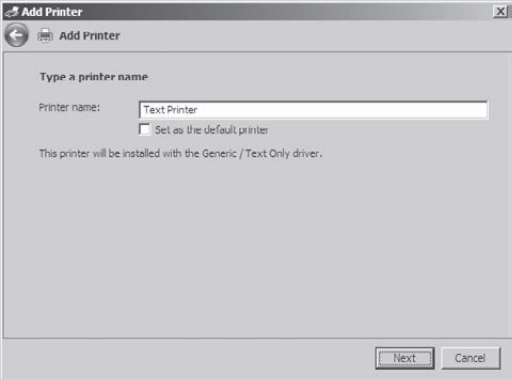
The
Installing Printer screen appears. After the system is finished, the
Printer Sharing page appears. Make sure the box labeled "Share this
printer so that others on your network can find and use it" is selected
and accept the default share name of Text Printer. In the Location section, type Building 203, and in the Comment section, add the following comment: This is a text-only Printer. Click Next.
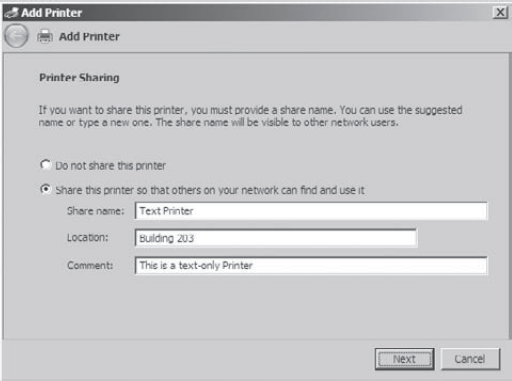
On the You've Successfully Added Text Printer page, click Finish.
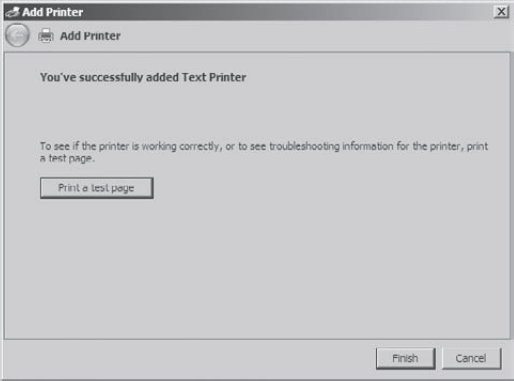
Next, you need to verify that the printer will be listed in Active Directory. Click Start => Control Panel => Printers, then right-click the Text Printer icon and select Properties. Next,
select the Sharing tab, and ensure that the List In The Directory box
is checked. Note that you can also add additional printer drivers for
other operating systems using this tab. Click OK to accept the settings.
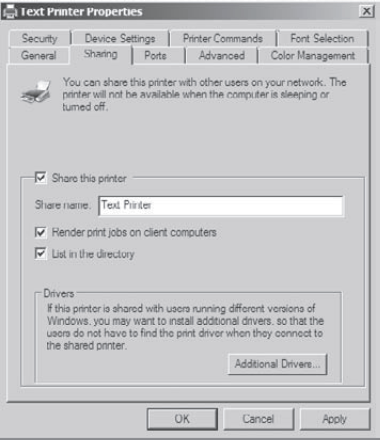
|
Note that when you create and share a
printer this way, an Active Directory Printer object is not displayed
within the Active Directory Users And Computers tool. The printer is
actually associated with the Computer object to which it is connected.
Printer objects in Active Directory are manually created for sharing
printers from Windows NT 4 and earlier shared printer resources.